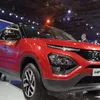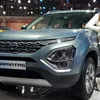From Tata Sierra and Safari to now an EV – Tata Motors hits the road with concept electric SUV
From being an oil-burning SUV in the early 90s to a futuristic electric SUV, the Sierra has come a long way.
Tata Motors, which is known for some of the most exciting concept cars, lived up to its expectations at this year’s Auto Expo 2020.
Paying homage to the legendary Sierra SUV, the company showcased the Tata Sierra EV concept, an all-electric SUV, which brings with it a rush of memories and a beacon of hope for the future.
Here’s all you need to know about the new Sierra EV.
Origin of Sierra
The Tata Sierra was introduced for the first time in 1991. Not only was it the first off-road SUV by the manufacturer, but also the first car produced in India with electric windows, air conditioning, and adjustable steering wheel. Even the humble tachometer made its first debut in the Sierra.

Powering the Sierra was a 2.0-litre four-cylinder diesel engine sourced from Peugeot. Initially sold as a naturally-aspirated engine, the Sierra had a top speed of 130 kmph. This engine was given a turbocharger in 1998, which helped not only increase the power output but also the top speed to 160 kmph. Tata retailed the Sierra in two variants - a rear wheel drive and a four-wheel drive variant.
Tata even exported the Sierra to Spain, France, Germany, and Italy. In fact, Italy even got a special dual-tone paint scheme designed by the iconic Italian designer Orciari.
However, the three-door car did not received the desired commercial success, and was replaced by the Safari in 2000. But its off-road capabilities and highway stability won the hearts of enthusiasts.
Safari times
The Safari, which was launched as a replacement to the Sierra, attained cult status. Initially the SUV was retailed with the same 2.0-litre Peugeot derived diesel mill. A 2.1-litre petrol (135 PS), developed by Tata and Austrian engine maker AVL, was on offer from 2003, but was later discontinued around 2005. Some of the key reasons why the petrol Safari was discontinued were a high price tag and a low fuel economy.
Later, in 2005, the company introduced a Mercedes derived 3.0-litre diesel engine, which had a significantly lower price tag than the outgoing petrol version. While its value for money proposition did win it laurels, its low reliability led to frequent breakdowns. This saw the entry of the 2.2-litre diesel mill, which was originally the DW12 mill from the PSA group. Tata, along with AVL, tuned it for Indian conditions.
Sagar Parikh, Chief Editor of one of India’s leading and oldest automobile news website, believes the key to Safari’s success has been the positioning of the product and lack of affordable competition.
He says, “Safari was the only affordable, full-size SUV made in India at the time of its launch. Its competitors like the Pajero Sport were imports and were therefore significantly more expensive. Tata also triumphed because of a larger dealer network and easy access to service centres, especially in the rural markets.”
The Safari though failed to garner an audience with the rise of soft-roaders by Renault (Duster), Ford (EcoSport), Hyundai (Creta) and Maruti (Vitara Brezza). Tata continued to offer minor cosmetic upgrades to the Safari, which didn’t go too well with the customers.
Sagar adds, “Monocoque architecture-based soft-roader SUVs boast of superior comfort and more advanced technologies and features.”
Tata finally had to succumb and decided to stop retailing the Safari to private customers last year. The company will soon be launching the Gravitas, which was unveiled at the recently concluded Auto Expo 2020.

The cult SUV is now being seen as a collector’s item. AutoStory connected with Aariz, who bought the last 4x4 variant of the Safari in the national capital.
He said, “Safari has been my all-time favourite SUV. The driving pleasure it offers with a commanding view is unmatched. When I heard it got discontinued, I started hunting for one and got lucky enough to find one of the last units left. The old school charm of the Safari can only be felt, it can’t be put into words.”
At the Delhi Auto Expo 2020, Tata Motors confirmed that the company will be badging its future 4x4 variants of its products. It showcased the first example of this with the Hexa Safari concept at the Expo.
Reborn with an electric heart
The company realised the Sierra brand name brings fond memories to many, and finally decided to capitalise on its brand recall value. Based on the Impact 2.0 design philosophy, the Sierra EV carries forward the signature styling elements of the original SUV, especially the warp around glass panel in the back.
In fact, that was the starting point on the design board of the new Sierra EV. It is being pitched as a recreational vehicle used to take a break from daily life. The interiors boast of a simple dashboard with just a single screen, which works as a driver information panel. A major part of the new electric SUV concept is keeping all forms of digital devices at bay.
Designed at Tata Motors’ European Technical Centre in Coventry, the UK, the Sierra EV also features sliding doors, which can be activated at the touch of a button. The B-pillar of the SUV gets a beacon light, which helps in mood lighting.

While the panoramic glass sunroof adds to the majesty of the car, the rear passenger seats and the rotatable front passenger seats makes it a unique concept model, following a trend previously unseen in India.
However, enthusiasts do not want an electric only modern-day Sierra. Aariz added, “When I saw the Sierra Concept at the Auto Expo, I had goosebumps. Looking forward to the retro silhouette of the 90s era.”
Being a petrol head, he adds, “I hope it comes with an internal combustion engine option too along with an electric powertrain.”
Tata Motors will be using the Alfa Architecture, an advanced, modular platform for the Sierra EV. However, at 4,150 mm long, the new SUV is smaller than the original Sierra.
The company has not yet officially confirmed a launch timeline for the new Sierra. We expect the company to bring out a toned-down version of the Sierra towards the end of 2022, or in 2023.
(Edited by Megha Reddy)










![[YS Exclusive] Nino Foods raises $1.6M from Y Combinator, Soma Capital, others](https://images.yourstory.com/cs/2/d72b5ef09db411ebb4167b901dac470c/Image14gf-1634813418981.jpg?mode=crop&crop=faces&ar=1%3A1&format=auto&w=1920&q=75)